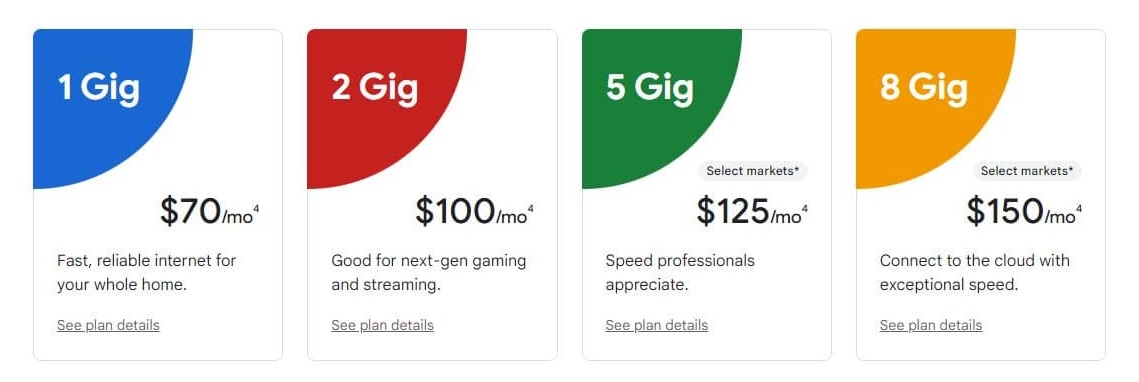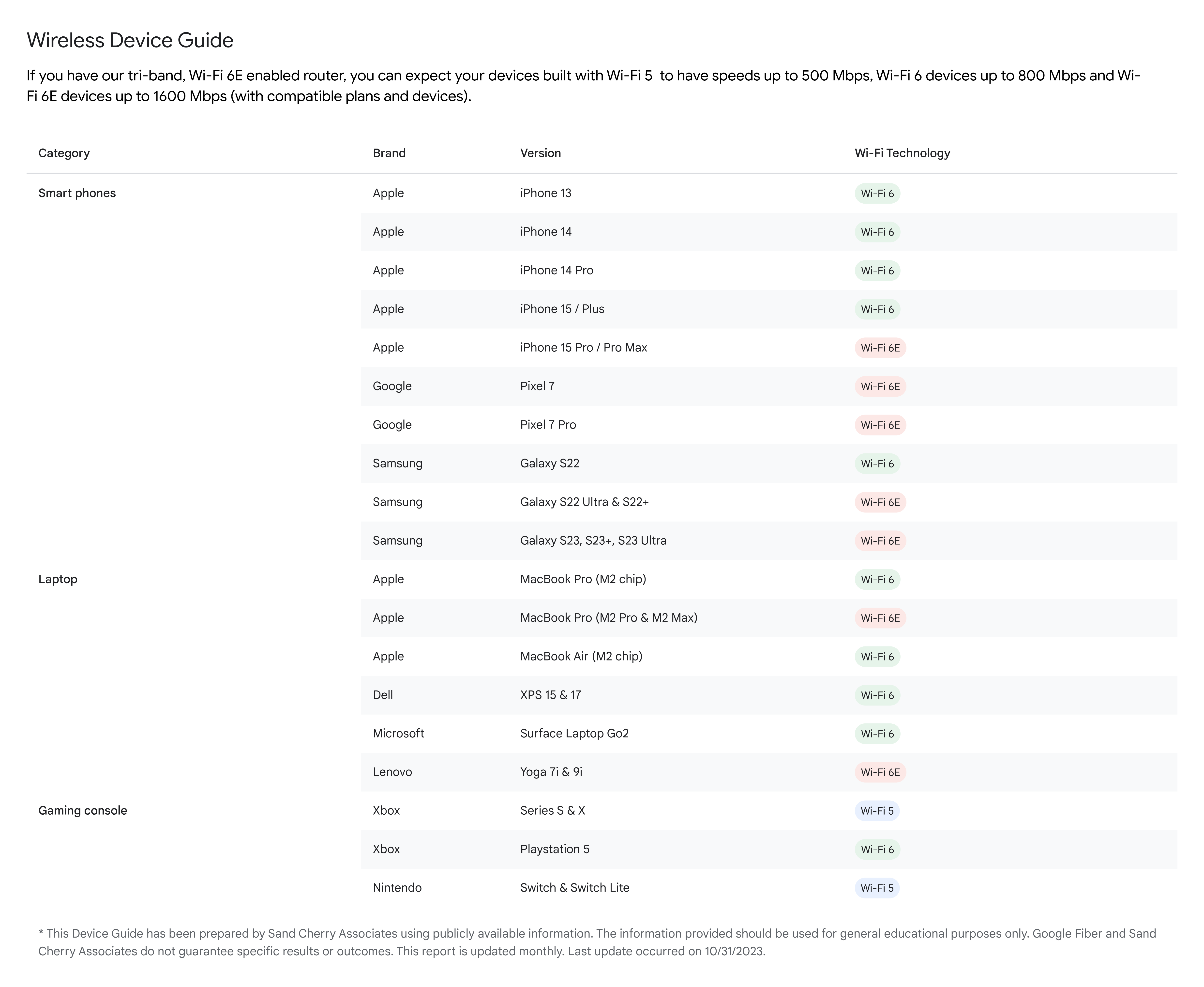Tag Archives: product news
GFiber Labs: Exploring the path to 100 Gig
A year ago, GFiber Labs announced 20 Gig + Wi-Fi 7 at Network X in Paris, and just this summer, we went a step further, testing 50 Gig on our network in Kansas City. As 2024 Network X gets underway, we’re excited to continue our work towards 100 Gig with the publication of a white paper with Ciena on Optimizing Passive Optical Networks with Coherent Innovation. I’d like to say a special thank you to the peer reviewers, as always these types of projects are always a true collaboration and exemplify the kind of work we do at GFiber Labs.
This paper explores how 100G CPON could potentially future-proof fiber networks with consideration of growing demands for bandwidth and service, discussing the requirements and opportunities to make this technology a reality and to get it widely deployed. GFiber is committed to ensuring that our network anticipates consumer needs and is ready to support increased demand in advance. Understanding and exploring advanced PON technologies is a key piece of delivering on that promise.
The future of the internet is wildly exciting. GFiber Labs will continue to further the conversation and innovation around what’s next for internet and how we can bring these opportunities to life to make the internet better for everyone.
Posted by Hani Elmaky, Head of Network Planning & Engineering
Source: Google Fiber Blog
Stay connected with mesh extenders
- Connect the mesh extender’s adapter to a power source.
- Connect the mesh extender to the router using the ethernet cables.
- Wait for the blinking white status light to turn green on the mesh extender. (The green status color means the mesh extender is now paired to your router).
Source: Google Fiber Blog
GFiber Labs: Tomorrow’s internet today
When we launched GFiber Labs last fall, we asked some big questions designed to help us meet the audacious goal of figuring out what’s possible for the internet and what tomorrow’s internet experience should be. While we don’t have all the answers, one certainty is that tomorrow’s internet will need to be faster. Which is why GFiber Labs is on a journey to push speeds to 100 Gig and beyond. Delivering 20 Gig symmetrical speeds was the first stop in pursuing that goal, but journeys are made by next steps. And we recently took that step in our hometown of Kansas City.
For the first time ever, GFiber Labs, using Nokia’s technology, tested 50 Gig on a live network. We put Nokia’s 50G PON technology to the test in one of our KC fiber huts (where we house our network equipment):
GFiber’s philosophy when it comes to our network is that all our customers should have access to the latest technology — whether they’re in the first neighborhood we served in Kansas City or in our newest construction areas in our most recently launched city of Omaha and everywhere in between. That’s why we’ve upgraded our network holistically to XGS-PON wherever possible, enabling 8 Gig speeds and above in all our cities. We are already seeing high interest in our multigig products. And it’s why we’re now working to deploy Nokia 25G PON in all of our markets by the end of the year, so that we can extend access to GFiber Lab’s 20 Gig plan. We already have customers putting this new level of service to the test in North Carolina’s Triangle, and we’re adding new customers to the early access program in select markets.
So when we start testing new technologies, like 50G PON, you know that it’s more than just an experiment or fun stunt for our engineers to geek out over (although, believe me, we did that too!). GFiber sees a future where the internet must meet the demands of increasing users, devices, and bandwidth hungry applications, including immersive video streaming, virtual and augmented reality experiences, artificial intelligence integration into everyday life, and quantum computing. Multigig is already the new norm. But to meet the challenge of this connected future, we are preparing to further densify our network so when bandwidth needs inevitably multiply, we’ll be ready. We are building a state-of-the-art network and we always want to stay ahead of demand when it comes to our infrastructure. 50G PON has the advantage of co-existing with XGS-PON and 25G PON to make the technology transition easier, which may make it the solution for the future.
These technologies don’t just mean we can deliver benchmark speeds to the home, they ensure our network is reliable and can meet fluctuations in demand. . .say when a certain hometown team goes to that big game in February, EVERY February. GFiber Labs is working to make sure that customers get the experience they deserve at every point of their service — the fastest speeds to the home, using the latest Wi-Fi technology to take advantage of those speed inside and even outside the home, and making sure all of that is supported by a network that fixes problems before they even occur.
A customer experience that changes the way we think about internet - that’s what GFiber has always strived to deliver, and as internet needs evolve, we aim to continue to meet that challenge for our customers. Testing 50 Gig brings us one step closer to tomorrow. The journey continues.
Posted by Liz Hsu, Senior Director, Product & Billing
Source: Google Fiber Blog
Business at Full Speed in San Antonio
Source: Google Fiber Blog
An upgraded network to deliver next generation multi-gig internet service
Source: Google Fiber Blog
Now, everything’s really up-to-date in Kansas City – 8 Gig available in all GFiber KC service areas
Source: Google Fiber Blog
Speed on Business-Trimming with Speed
Source: Google Fiber Blog
CES 2024: Wi-Fi 7 and the future of connectivity

This news of the next generation of Wi-Fi definitely made waves at CES 2024. The event buzzed with announcements of lots of new devices that support Wi-Fi 7 — from smartphones, to smart home devices, to more innovative devices — the industry has begun gearing up to embrace the power of Wi-Fi 7. Google Fiber is no exception — we’re excited about the Wi-Fi Alliance’s certification of Wi-Fi 7 because it opens the door to even more multi-gig speeds and reduced latency over Wi-Fi networks.

The biggest innovation with Wi-Fi 7 is Multi-Link Operation (MLO), which allows packets to be sent over multiple frequencies simultaneously. Prior generations of Wi-Fi only used one frequency band at a time.This means that one device which supports Wi-Fi 7 can talk to an access point over multiple radios and frequency bands at the same time.
Wi-Fi 7 devices can select from either a 2.4, 5, or 6 GHz band and are able to choose the Wi-Fi band that offers the most efficient and reliable path to the router. The result is lower latency and improved reliability, resulting in a better experience for internet users.
We know that great wireless internet is key to our customers’ in-home experience, so we spend a lot of time working on making it better (even when it’s already good). In 2023, we deployed Wi-Fi 6E routers with tri-band connectivity, built to handle more devices with fewer slowdowns.
Our focus and commitment to delivering speed to the home and in the home is exactly why we’re including a Wi-Fi 7 router for GFiber Labs 20 Gig customers. Wi-Fi 7 is a longer-term solution, if you’re thinking about purchasing a new smartphone, TV, tablet, computer, or other devices in 2024, you may want to consider whether they are Wi-Fi 7 compatible. You can have the latest high-powered router but the compatibility of your Wi-Fi devices also impacts your online experience. Our device guide can help determine Wi-Fi compatibility for your devices.
CES exhibitors unveiled cool new devices and products that support Wi-Fi 7 and are coming soon. Dell introduced two new laptops — the Dell XPS 16 laptop and the Dell Alienware M15 R2 gaming laptop, which are expected to be released in Q1 '24. Samsung announced its Galaxy S24 Ultra smartphone, and Acer announced a new gaming router; the Wi-Fi 7 Predator Connect X7 5G CPE, which offers dual connectivity (an ethernet network and 5G service).
Wi-Fi Alliance’s certification of Wi-Fi 7 ushers in a host of new possibilities, and GFiber is committed to making sure that our customers can harness the speed of their internet. Expect more from us soon to help make your in-home internet even faster.
Posted by Ishan Patel, Product Manager

Want more content like this in your inbox? Subscribe to get the GFiber blog in your email.
Source: Google Fiber Blog
Wi-Fi Focus: How to Get the Best Wi-Fi On Your Devices
Understanding your Wi-Fi technology and how it was built to support your devices is the key to getting the most out of them. Why? Because many of the Wi-Fi enabled devices in your home were built on a Wi-Fi standard, which impacts the Wi-Fi speeds you'll get.
What’s a Wi-Fi standard?
A Wi-Fi standard is a set of rules created by the The Institute of Electrical and Electronics Engineers (IEEE). The IEEE is the world's largest technical professional organization that defines how Wi-Fi devices communicate with each other. In short, it’s the system your devices use when connecting wirelessly. There are many different Wi-Fi standards, also called Wi-Fi technologies. Some standards you may be familiar with are Wi-Fi 5, Wi-Fi 6, Wi-Fi 6E and the soon-to-launch, Wi-Fi 7. Each new Wi-Fi standard is faster and more efficient than the previous one. (That’s why older devices may not go as fast as newer ones.)
Want to see what we’re doing with Wi-Fi 7? Check out our demo
How do Wi-Fi standards impact devices?
Some devices only support certain standards of Wi-Fi technology. So when you're shopping for a new Wi-Fi router, it's really important to make sure that it supports the Wi-Fi standard your devices or future devices are enabled for. For example, if you have a phone that supports Wi-Fi 6 or 7, you'll want to get a router that also supports those standards so you can take advantage of faster speeds and better performance. Making sure that your devices’ technology is compatible with your router technology will help you utilize the fastest Wi-Fi speeds available and avoid lag times.
Want to know how fast your devices can go?
Posted By Sydney Lauer, Product Strategy Analyst













.png)

.jpg)

.jpeg)

.jpg)

.jpg)


